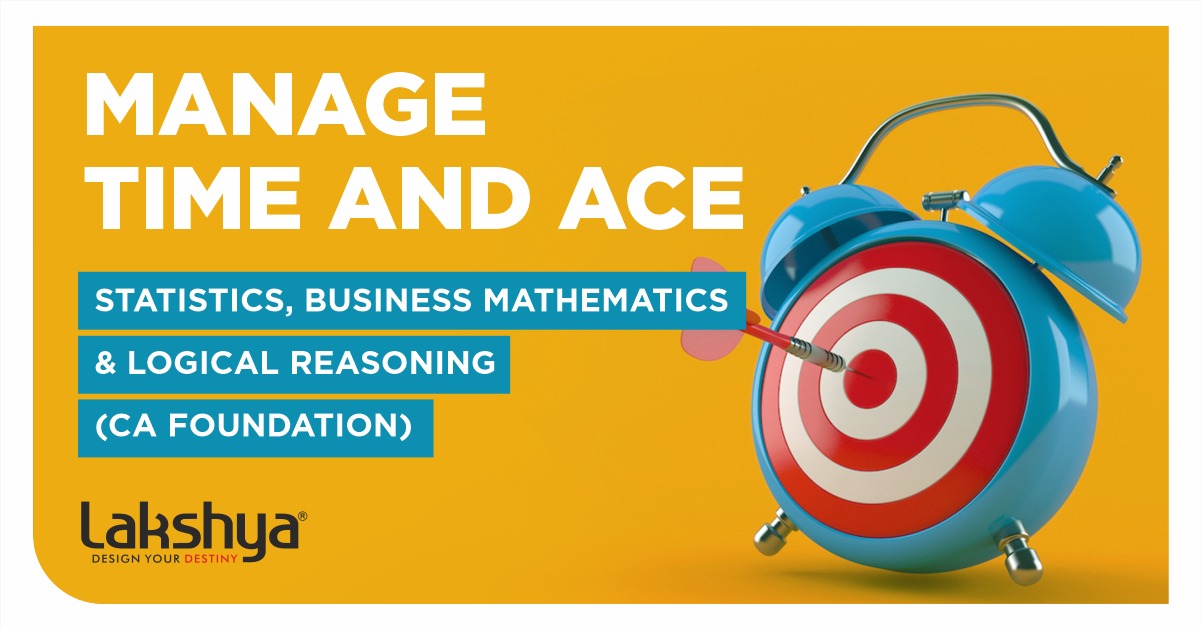Managing time is one of the biggest reasons why students are unable to clear the paper successfully. Papers such as Statistics, Business Mathematics and logical reasoning eat up your time without you even realising it. In this blog post, we will help you to manage time more effectively.
These are just a few of the suggestions. Try and bring in your viewpoints and adapt it to your needs.ICAI has divided the paper into 3 parts: Mathematics, logical reasoning and Statistics.
The paper will contain 100 questions and you are expected to solve this in under 2 hours. Which means you have roughly a minute per question. You can finish each and every question - if and only if you plan it.
The 5 steps that will ensure you crack the time equation
- Segregate the questions and solve the easy questions first
- Move onto solving statistics related questions
- Next, solve questions related to logical reasoning
- Finally solve Business Mathematics questions
- Now check, check and check to see if all questions are right
As mentioned above the very first thing one must do is to properly analyse the questions and find out each question. Solve the easier questions first. As you have identified these questions, solve them and then categorise the rest depending on the topics.
Move first to tackle questions from statistics, then logical reasoning and finally the business mathematics questions. All questions that need calculations should be kept for last. Questions from statistics would be mostly theory and won’t have a lot of calculation, so solve these quickly. The order in which questions are solved are not important.
Each category requires a totally different strategy. You need to take time to go through each segment. Let’s see the breakdown plan.
The time needed for each segment
- Segregate the questions and solve the easy questions first - 15 to 20 minutes
- Move onto solving statistics related questions - 25 to 30 minutes
- Next, solve questions related to logical reasoning - 15 to 20 minutes
- Finally solve Business Mathematics questions - 40 to 45 minutes
- Now check, check and check to see if all questions are right - 5 to 25 minutes
Step 1
Run over the questions as soon as you get it. Spend 10-15 minutes to identify which category each question belongs to. Find questions that you find easy, and try to solve it quickly. In this manner, you can maybe solve 10-15 questions. If you are lucky, maybe even 20-30. It may not be possible for you to specify each question precisely but try to the best of your capability. Once this is done, you can move to Step 2.
Step 2
Now it's time to find the statistics questions. But which goes first?
Now you have to split the questions and split it topic wise. So what we have done is rank the topics with the easiest at the top.
- Statistical Description of Data
- Index Numbers and Time Series
- Theoretical Distributions
- Correlations and Regression
- Measures of Central Tendency and Dispersion
- Probability
You can rearrange it according to your strengths and weaknesses, this is just a rough template.
After you have solved all these questions. You can move ahead from the statistics questions. You may take 20-30 minutes to finish this session. Do not take anymore time with these questions.
Now we move onto Logical Reasoning section
Step 3:
Logical reasoning is usually an easier section for most. We will again arrange this in terms of ease.
- Number series, Coding, Decoding and Odd Man Out Series
- Direction Sense Test
- Seating Arrangements
- Blood Relations
- Syllogism
Again as mentioned in the earlier portion, this is not a set or final part. Feel free to rearrange it according to your ease. You should ideally take about 15 - 20 minutes to solve these. Leave the questions you haven't solved after this time and come back to it later.
Step 4:
Business Maths is the only topic that will be left as you progress through the question paper in this manner. You could solve it in this suggested order
- Ratio and Proportion, Indices and Logarithms
- Equations and Matrices
- Linear Inequalities
- Sets, Relations and Functions
- Sequence and Series – Arithmetic and Geometric Progressions
- Basic Concepts of Differential and Integral Calculus
- Basic Concepts of Permutations and Combinations
- Time Value of Money
Step 5:
Once you have done all these steps cross-check all the questions. If you have about 20-30 minutes left then, try and finish up the other questions. Try to keep 10-15 minutes. Now you have to let go of the questions you couldn’t complete and then just make sure that the ones you have answered are correct.
Try and check your answer at least 3 times. You should take just about 5 minutes each time you do it. While you go through these you may suddenly get a better idea of how to solve the other questions. So do that in the final few minutes.
Conclusion
So as mentioned before please don't take this as a set pattern. It will totally change depending on what your strengths and weaknesses are. Now about skipping questions. If you do find a question very hard to solve, then it is better if you skip it, ie if you take more than 2-3 minutes to solve a question, then you know that either the question is too hard or you haven’t prepared well enough. In either case, instead of focusing on this and getting a frustrated move to the next question. You can take 2-3 minutes later on to try and solve the question.

 ABOUT LAKSHYA
ABOUT LAKSHYA  WHY CHOOSE LAKSHYA
WHY CHOOSE LAKSHYA  MISSION AND VISION
MISSION AND VISION  CHARTERED ACCOUNTANCY (CA)
CHARTERED ACCOUNTANCY (CA)  ACCA
ACCA  CMA-USA
CMA-USA  RESULTS
RESULTS 


